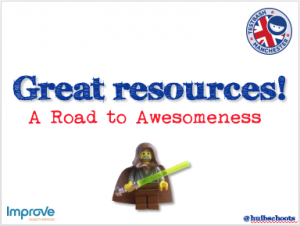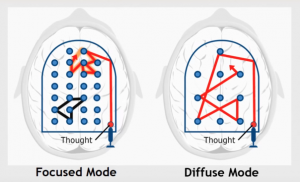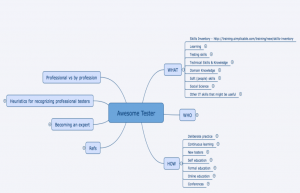At TestBash Manchester I did a presentation titled “A road to awesomeness”.  In this talk I tried to explain how testers can become awesome. I talked about learning and testing skills. To prepare this talk I created a mind map to list skills and ways to learn. The mind map is here and will be continuously updated in the future. Let me know if you have things to add.
In this talk I tried to explain how testers can become awesome. I talked about learning and testing skills. To prepare this talk I created a mind map to list skills and ways to learn. The mind map is here and will be continuously updated in the future. Let me know if you have things to add.
The 4-hour tester
In another talk at TestBash Manchester Helena Jeret-Mäe and Joep Schuurkes talked about the 4-hour Tester Experiment. They took the the challenge of teaching new testers useful skills in only 4 hours. They focus on 5 skills:
- Interpretation
- Modeling
- Test design
- Note taking
- Bug reporting
Their experiment is an interesting try to teach software testers essential skills in only 4 hours. Of course it is impossible to teach anyone to test in 4 hours. But the 4-hour tester has simple exercises that take at most one hour to complete. Interesting approach to help inexperienced testers to get started.
Learning
To become awesome, you have to learn a lot. But how do we learn? I like the 10/20/70 model: 70 percent of learning comes form job-related experiences, 20 percent from interactions with others, and 10 percent from formal educational. So training is only a small part of a learning journey. Interaction with others, like communities and networking, coaching and mentoring are a part of it as well. But the biggest part of learning takes place from work related experience. This doesn’t mean just working. Many years of working doesn’t let you necessarily learn effective if you do not get feedback, reflect on what you do in the right environment. Doing the same work for 10 years doesn’t give you 10 years of useful experience. If you never retrospect, reflect or get any feedback, I’d say you have 10 times 1 year of experience. To make learning effective in your job you need:
- Concrete, challenging and achievable tasks
- Realistic application of skills, processing and reflection
- Personal interpretation, exchange with others and constructive feedback
- A safe environment to experiment and make mistakes
But there is more to learning. In her TED Talk “Learning how to learn” Barbara Oakley talks about two fundamental learning modes of our brain: focused mode and the more relaxed diffused mode. When your are learning, you want to go back and forth between these two modes. When you are stuck, you defocus going into the diffused mode, generating new ideas. If you want to learn more about this, I recommend the coursera MOOC “Learning How to Learn: Powerful mental tools to help you master tough subjects“. Two of the things I took from that course is that active listening (e.g. by asking questions) is far more effective. Also learning by doing is a great way to learn fast.
modes of our brain: focused mode and the more relaxed diffused mode. When your are learning, you want to go back and forth between these two modes. When you are stuck, you defocus going into the diffused mode, generating new ideas. If you want to learn more about this, I recommend the coursera MOOC “Learning How to Learn: Powerful mental tools to help you master tough subjects“. Two of the things I took from that course is that active listening (e.g. by asking questions) is far more effective. Also learning by doing is a great way to learn fast.
Learning is the most important skill for a tester. And learning is closely related to thinking skills. I’ll come to that later.
What makes an awesome tester?
An awesome testers has many skills. In my blogpost “Heuristics for recognizing professional testers” I described 18 heuristics to recognize professional testers. This was the starting point for my talk at TestBash Manchester. The first steps to help me think about aspects to become awesome, was creating a mind map with a couple of things to focus on: what makes an awesome tester: who (characteristics), what (skills) and how (ways to learn and how to become an expert).
 There are many skills that make an awesome tester. I think the most important skill is the ability to learn! Remember the definition of testing we use in Rapid Software Testing: “Testing is evaluating a product by learning about it through exploration and experimentation”. Besides learning I identified 5 categories of skills testers need:
There are many skills that make an awesome tester. I think the most important skill is the ability to learn! Remember the definition of testing we use in Rapid Software Testing: “Testing is evaluating a product by learning about it through exploration and experimentation”. Besides learning I identified 5 categories of skills testers need:
- Thinking skills
- Testing skills
- Technical skills
- Domain skills
- Soft skills
And of course there are many, many skills that make these categories. Have a look at the mind map to learn more about these skills. It is very important to recognise what skills are involved in being a great tester. If you want to learn, you need to know what to focus on. Not knowing which skill to train, will result in unfocussed and ineffective learning. I see many testers apply test techniques without knowing what skills are used and which methods are underneath the technique. This makes them apply techniques as recipes or trick. Being able to apply approaches, tactics and techniques effectively in any situation requires the right skills.
Thinking skills
Learning and thinking are closely related. While researching thinking and thinking skills, I stumbled upon a great TED talk by Dr. Derek Cabrera called ”How Thinking Works”. He talks about the schooling system and about 4 universal thinking skills. Schools nowadays are over-engineering the content curriculum: students do not learn to think, they learn to memorize stuff. Kids are learned to follow instructions, like painting by the numbers. To fix this, we need to learn how to think better and for that he suggests four thinking skills: DSRP. A simple set of rules to become better in systems thinking.
- Making Distinctions – Any idea or thing can be distinguished from other ideas or things
- Organizing Systems – Any ideas or thing can be split into parts or lumped into a whole
- Recognizing Relationships – Any idea or thing can relate to other ideas or thing
- Taking Perspectives – Any idea or thing can be the point or the view of a perspective
In his book “Systems thinking made simple“, Dr. Cabrera talks metacognition. “Systems thinking is a particular type of metacognition that focuses on and attempts to reconcile the mismatch between one’s mental models and how the real world works”, he continues to describe acts of metacognition: “Awareness that everything you experience is a mental model that approximates (either poorly or well) the real world”, “The ability to distinguish among cognition (thinking), emotion (feelings), and conation (motivations) and the awareness of how these different human capacities influence our mental models and behavior”. Recognizing that models are a big part of our thinking makes you a better tester. But also that your biases and emotions influence your thinking are great insights we have to take into account in our testing.
A second TED talk I recommend is “How to think, not what to think” by Jesse Richardson. He says: “The way we approach education needs to adapt! What’s different in teaching children how to think, we are involving them in the process of their own learning. Instead of just telling them to memorize the right answer, we ask them to engage their own minds, their own awareness by questioning things, attaining understanding not just knowledge. And that involvement, that engagement, is so important, because it keeps the spark of curiosity alive.”
He mentions the famous TED Talk by Ken Robinson: “Do schools kill creativity?“. One of my all time favorites.
Activities in testing
To fully understand what skills we use in testing, I made a list of testing activities. In Rapid Software Testing we teach the 9 Elements of testing and I took these as a starting point.
- Model the test space and risks
- Determine coverage
- Determine oracles
- Determine test procedures
- Configure the test system
- Operate the test system
- Observe the test system
- Evaluate the test results
- Report test results
The next step was to zoom in on the different elements in the list. Zooming in on “Model the test space and risks” we can distinguish:
- Context Analysis
- Creating a product Coverage Outline
- Test Plan
- Test scope
- Risk & Value Analysis
I did this with all 9 elements and came to a pretty long list of activities. Maybe you can think of more activities testers do, let me know if you do.
This (making distinctions or factoring) exercise resulted in a huge list of things we do in testing and products we make. The next step was to lists the skills that we use, doing these activities. Obviously the first thing I thought of was learning and thinking. Researching this, I stumbled upon a lot of interesting stuff, of which part I have described earlier. But there was more, way more as you can see in my mind map. And this mind map expands every time I visit it. Factoring the activities and skills helps me to see what is really going on while we are testing.
So how do you become awesome?
So now we have a map of activities and skills. But how do we learn them? And where do we start?
The most important part of becoming awesome is knowing what to learn and how. The first step is to know what to learn and focus on that. Stop trying to learn 10 things at the same time, it doesn’t work! A way to get to know what you want to learn is writing a Personal Development Plan answering 5 simple questions: Who am I? What are my skills? What do I want? What do I need? How do I get there? This can give you great insight in your skills, ambition and learning needs. The second step is to find mentors who can help you and give you feedback. After that it is “just” a matter of doing it and practice!
I learned to be awesome by doing many things:
- Observing others and myself: by becoming manager and a coach I found out that observing others gives you great insight in how testing is done and what the common problems are for people who are learning how to test. Observing myself, which is quite difficult in the beginning, I learned what I was doing and I found out that this was a big eye-opener and learning enabler. Using a journal a writing down stuff every day on my way home, gave me great insights in what my problems were. Knowing your problems, is the first step to solving them.
- Explaining, presenting, teaching & coaching: by explaining stuff to others, you learn to structure your thoughts. To be able to present or teach you really have to know your stuff. And still every time I teach, I learn new things about what I teach. New examples, new problems, new ways of doing things. Also answering difficult questions is very helpful learn deeply about topics. That is way I think we should encourage debate and questioning at conference way more.
- Pairing: pairing is a fun and nice way to learn from others. Seeing how others do things is helpful and has many learning opportunities. Also the feedback you get from your pairing-partner is valuable.
- Writing my blog: same thing as explaining and teaching. Writing this blog post made me think about what o write and how to explain. I needed to structure my thoughts. Great exercise.
- Keeping a journal: see observing other and myself.
- Always having a notebook with me: to practice note taking and it also helps me not to forget interesting stuff that others tell me. It is great to read back notes from conferences and courses from way back. It refreshes my memory and I often see new insights I didn’t see before.
- Discussing & debating testing: see explaining.
- Trying new stuff: experimenting is fun and also a way to learn about new techniques, tools, approaches, etc.
- My coaches and mentors: I have had and still have many mentors. All these people help me to become better every day. It is great to have many mentors, each with their own expertise and specialties. I have a big international network of people I know and who I work with. So many sources of knowledge and skill help me quickly find an answer to almost every difficult testing problem I have.
My advise is to try the same exercise I did creating the mind map. Create your own model of test activities and skills. Observe what you do, how you do it and make your own mind map (or any other way you would like to model it). Come back and compare yours to my mind map.
So why is this important?
I see may similarities with the problems in the current schooling system and in testing: over-engineering the content curriculum, students do not learn to think, they learn to memorize stuff and to follow instructions (like painting by the numbers). In most testing classes testers learn tricks, procedures and the use of template like approaches in stead of the required skills to do an excellent job. In Rapid Software Testing (RST) we teach thinking skills. We learn testers how to effectively think and solve problems instead of using tricks, templates and standards to do their work. By learning to think better, you learn better. And isn’t testing all about learning? Also, if you are able to think, you are able to do better work, apply your skills in the right way. Adapt to changing context, find your own solution to problems that occur. We also teach testers to dynamically manage their focus: focus/defocus is similar to fundamental learning modes Prof. Dr. Barbara Oakley talks about in her TED Talk.
The DSRP model (distinctions, systems, relationships, perspectives) is very useful in testing. In RST we talk about models and learn our students how to model (distinctions, systems and relationships) and to think from different perspectives using a diverse strategy using heuristics. Great to see that the stuff we teach is actually backed up by scientists who study metacognition (thinking about thinking) and epistemology (the study of knowledge). Making a product coverage outline for instance helps you see distinctions and relations and helps systems thinking.
Good luck on your journey to awesomeness!
References
The slides I used in Manchester are here: slideshare.
The updated slides are here: pdf.
All talks at TestBash are recorded. My talk is here.



Recent Comments